|
1344.
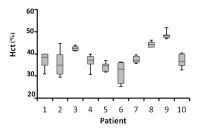 |
Effect of measured Hematocrit value on Glioma grading using
Dynamic contrast enhanced derived MR perfusion parameter
Prativa Sahoo1, Pradeep Kumar Gupta2,
Ashish Awasthi3, Chandra Mani Pandey3,
Rana Patir4, Sandeep Vaishya5, and
Rakesh Kumar Gupta2
1Healthcare, Philips India ltd, Bangalore, India, 2Radiology
and Imaging, Fortis Memorial Research Institute, Gurgaon,
India, 3Biostatistics,
Sanjay Gandhi Post Graduate Institute of Medical Sciences,
Lucknow, India,4Neuorsurgury, Fortis Memorial
Research Institute, Gurgaon, India, 5Neuorsurgury,
Fortis Memorial Research Institute, Lucknow, India
Quantification of DCE-MRI assumes a constant blood
hematocrite (Hct ) of 45% for adult human papulation.
However Hct varies with disease condition and more with
chemotherapy. Correction of the measured signal for blood
Hct level is important as blood T1, quantification of
contrast agent and arterial input function is dependent on
it. Purpose of this study was to investigate the influence
of Hct values on glioma grading using DCE-MRI derived
perfusion parameters. Study suggest that even though grading
of glioma not influenced by Hct values it does affect the
kinetic parameters and might be important for monitoring
serial assessment of disease progressions.
|
|
1345.
 |
Can dynamic contrast enhanced MR perfusion metrics accurately
discriminate different grades of Gliomas?
Jitender Saini 1,
Pradeep Kumar Gupta2, Prativa Sahoo3,
Rana Patir4, Sandeep Vaishya5, Arun
Kumar Gupta1, Amey Savarderkar6, and
Rakesh Kumar Gupta2
1Neuroimaging & Interventional Radiology,
National Institute of Mental Health and Neurosciences,
Bangalore, India, 2Radiology
and Imaging, Fortis Memorial Research Institute, Gurgaon,
India, 3Healthcare,
Philips India ltd, Bangalore, India, 4Neuorsurgury,
Fortis Memorial Research Institute, Gurgaon, India, 5Neuorsurgury,
Fortis Memorial Research Institute, Lucknow, India, 6Neuorsurgury,
National Institute of Mental Health and Neurosciences,
Bangalore, India
Dynamic contrast enhanced MRI perfusion is a useful
technique for assessment of glioma grading. This technique
has been used in the past for discrimination of low from
high grade gliomas. This study investigates the ability of
DCE perfusion MRI to discriminate Grade II from Grade III
and Grade III from Grade IV gliomas. Various DCE
pharmacokinetic parameters were also analysed for their
ability to distinguish the various grades of gliomas.
|
|
1346.
 |
Investigation of hypoxia conditions using oxygenation enhance (OE)-MRI
measurements in C6 glioma models
Yingwei Wu1, Yongming Dai2, Qi Fan1,
and Xianfeng Tao1
1Shanghai Ninth People’s Hospital, School of
Medicine, Shanghai Jiao Tong University, Shanghai, China,
People's Republic of, 2Philips
Healthcare, Shanghai, China, People's Republic of
We used oxygenation enhancement (OE)-MRI measurements to
investigate hypoxia conditions of gliomas and to evaluate
relationship between histopathology measurements and PSC.
Oxygen amplitude maps of C6 glioma models were derived. ROI
max and ROI non-max were defined. Time-SI curve from ROI
areas was obtained and tissues from ROI areas was evaluated
for microvessel density and expression of HIF-1a. We found
that microvessel density in ROI non-max area were lower than
those in ROI max area and expression of HIF-1α in ROI
non-max area were higher than that in ROI max area. PSC had
a linear positive correlation with vessel density.
|
|
1347.
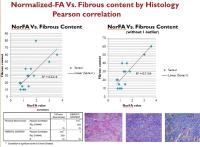 |
Quantitative DTI-FA Mapping in Prediction of Meningioma fibrous
content, Consistency and grade.
Shanker Raja1,2, Wafa AlShawkeer3,
Lama Mohammed Almudaimeegh3, Sadeq Al Dandan4,
and Sharad P George5
1Radiology, Baylor College of Medicine, Bellaire,
TX, United States, 2Radiology,
KFMC, Riyadh, Saudi Arabia, 3King
Khalid University Hospital, Riyadh, Saudi Arabia, 4King
Fahad Medical City, Riyadh, Saudi Arabia,5Baylor
College of Medicine, Houston, TX, United States
We utilized quantitative FA-maps derived from DTI to
evaluate the fibrous content consistency and grade of
meningioma. Our results suggest that, quantitative FA
mapping is promising in pre-operative prediction of meningioma
consistency pre-operatively, but only modestly correlates
with histologic grading
|
|
1348.
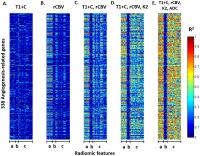 |
Imaging Angiogenesis Genotype of Glioblastoma by Radiomic
Features of Multi-modality MRI 
Chia-Feng Lu1,2,3, Fei-Ting Hsu4,
Li-Chun Hsieh4, Yu-Chieh Jill Kao1,2,
Hua-Shan Liu4,5, Ping-Huei Tsai2,4,
Pen-Yuan Liao4, and Cheng-Yu Chen1,2,4
1Translational Imaging Research Center, College
of Medicine, Taipei Medical University, Taipei, Taiwan, 2Department
of Radiology, School of Medicine, Taipei Medical University,
Taipei, Taiwan, 3Department
of Biomedical Imaging and Radiological Sciences, National
Yang-Ming University, Taipei, Taiwan, 4Department
of Medical Imaging, Taipei Medical University Hospital,
Taipei, Taiwan, 5Graduate
Institute of Clinical Medicine, Taipei Medical University,
Taipei, Taiwan
The multi-modality and multi-radomic-feature MRI may provide
a more efficient regression model for imaging gene
expressions than the conventional radiogenomic approach.
|
|
1349.
|
Optimization of glioma biopsy targeting applying T1-DCE MRI
parameter maps – A double-blinded prospective study
Vera Catharina Keil1, Bogdan Pintea2,
Gerrit H. Gielen3, Matthias Simon2,
Juergen Gieseke1,4, Hans Heinz Schild1,
and Dariusch Reza Hadizadeh1
1Department of Radiology, Universitätsklinikum
Bonn, Bonn, Germany, 2Clinic
for Neurosurgery and Stereotaxy, Universitätsklinikum Bonn,
Bonn, Germany, 3Department
of Neuropathology, Universitätsklinikum Bonn, Bonn, Germany, 4Philips
Healthcare, Best, Netherlands
Many centers refrain from implementing semi-quantitative MRI
techniques, such as T1w contrast-enhanced MRI (T1-DCE MRI),
as a benefit for the patient is questioned. To elucidate if
T1-DCE MRI has a benefit, we compared the standard
neurosurgical biopsy target selection method (based on T1w
contrast-enhanced or FLAIR maps) with a selection based on
“hot spots” on Ktrans maps
in a double-blinded, prospective setting with 27 glioma
patients. 87 tissue samples were taken (55 Ktrans-based,
32 standard). Ktrans-based selection showed a
strong tendency to be the more successful targeting method (glioblastoma:
n=20/39 vs. n=11/20; p=0.085; WHO III/II: n=12/13 vs.
n=6/11; p=0.061).
|
|
1350.
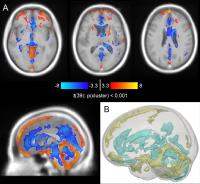 |
Cerebrospinal fluid compression in cerebellum on treatment-naïve
MRI might be an early indicator of poor survival in Glioblastoma:
A preliminary study
Gavin Hanson1, Prateek Prasanna1, Jay
Patel1, Anant Madabhushi1, and Pallavi
Tiwari1
1Department of Biomedical Engineering, Case
Western Reserve University, Cleveland, OH, United States
Glioblastoma Multiforme (GBM) is very aggressive form of
primary brain tumor, and a key part of GBM pathogenesis is
the mass effect of the tumor within the ridge container of
the brain vault. Mass effect is strongly associated with
mortality in patients with GBM. In this work, we seek to
quantify the extent of mass effect throughout the brain
volume as manifested on MRI to predict patient survival in
GBM patients. We use a MRI-driven tensor based morphometry
approach, combined with statistical mapping to allow the
identification of regions where the deformation associated
with mass effect is correlated with overall survival after
diagnosis.
|
|
1351.
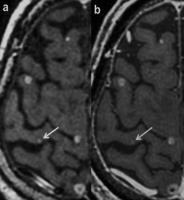 |
Gadolinium-DTPA-enhanced MR imaging of brain tumors:
comparison with T1-Cube and 3D fast spoiled gradient recall
acquisition in steady state sequences
Mungunkhuyag Majigsuren1,2, Takashi Abe2,
and Masafumi Harada2
1Mongolian National University of Medical
Sciences, Ulaanbaatar, Mongolia, 2The
University of Tokushima, Tokushima, Japan
We compared the gadolinium enhancement characteristics of a
heterogeneous population of brain tumors imaged by T1-Cube
and 3D FSPGR at 3T MRI with time-dependent changes. A
totally 91 lesions from 52 patients with brain tumors in 3T
MRI. Fifty-one of the 91 lesions (56.04%) were depicted with
T1-Cube first, and 40 lesions (43.96%), with 3D FSPGR first.
3D FSPGR images would be expected to exhibit greater
enhancement than T1-Cube images. However, the overall mean
CNR values were higher on T1-Cube images with both order
sequences. We suggest the superiority of T1-Cube to 3D FSPGR
for the detection of metastatic lesions.
|
|
1352.
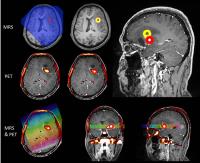 |
An MRS and PET guided biopsy tool for ultrasound-based
intra-operative neuro-navigational systems. 
Matthew Grech-Sollars1,2, Babar Vaqas3,
Gerard Thompson4, Tara Barwick2,5,
Lesley Honeyfield2, Kevin S O'Neill3,
and Adam D Waldman1,2
1Division of Brain Sciences, Imperial College
London, London, United Kingdom, 2Department
of Imaging, Imperial College NHS Healthcare Trust, London,
United Kingdom, 3Department
of Neurosurgery, Imperial College NHS Healthcare Trust,
London, United Kingdom, 4Department
of Neuroradiology, Salford Royal NHS Foundation Trust,
Salford, United Kingdom, 5Department
of Surgery and Cancer, Imperial College London, London,
United Kingdom
Glioma heterogeneity and the limitations of conventional
structural MRI to identify agrressive tumour components
limits targeting of stereotactic biopsy, and hence tumour
characterisation. In vivo MR spectroscopy and PET allow for
physiological characterisation of tumour and we here present
a method for representing MRS and PET defined regions to
biopsy using an ultrasound based neuronavigational system.
Our method involves using colour-coded hollow spheres to
represent the target biopsy regions, which can be easily
identified during the surgery. This approach can be applied
to target the most aggressive regions of a tumour and as a
tool for imaging biomarker validation.
|
|
1353.
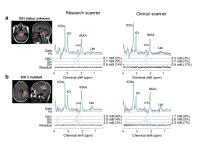 |
Translation of 2-hydroxyglutarate MR spectroscopy into clinics
Zhongxu An1, Sandeep Ganji1, Vivek
Tiwari1, Edward Pan2,3,4, Bruce Mickey2,4,5,
Elizabeth A. Maher2,3,5,6, and Changho Choi1,2,7
1Advanced Imaging Research Center, University of
Texas Southwestern Medical Center, Dallas, TX, United
States, 2Harold
C. Simmons Cancer Center, University of Texas Southwestern
Medical Center, Dallas, TX, United States, 3Department
of Neurology and Neurotherapeutics, University of Texas
Southwestern Medical Center, Dallas, TX, United States, 4Department
of Neurological Surgery, University of Texas Southwestern
Medical Center, Dallas, TX, United States, 5Annette
Strauss Center for Neuro-Oncology, University of Texas
Southwestern Medical Center, Dallas, TX, United States, 6Department
of Internal Medicine, University of Texas Southwestern
Medical Center, Dallas, TX, United States, 7Department
of Radiology, University of Texas Southwestern Medical
Center, Dallas, TX, United States
2-hydroxyglutarate (2HG) is an important biomarker for IDH-mutated
gliomas. Thus in vivo measurement of 2-hydroxyglutarate can
provide important information for brain tumor diagnosis and
prognosis. Several techniques for in-vivo detection
of 2HG were reported recently. However, due to limited
access to scan parameters in clinical setup, translation of
such techniques into clinics is limited. We report the
reproducibility of a recently developed clinically-available
PRESS-based 1H MRS method, for in vivo 2HG measurement at
research and clinical scanners.
|
|
1354.
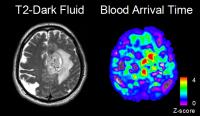 |
Tumor Classification Using Blood Arrival Histogram Obtained by
Resting-state fMRI
Tianyi Qian1, Yinyan Wang2,3, Kun Zhou4,
Yuanyuan Kang4, Shaowu Li2,5, and Tao
Jiang2,5
1MR Collaborations NE Asia, Siemens Healthcare,
Beijing, China, People's Republic of, 2Neurosurgery,
Tiantan Hospital, beijing, China, People's Republic of, 3Beijing
Neurosurgical Institute, Capital Medical University,
Beijing, China, People's Republic of, 4Siemens
Shenzhen Magnetic Resonance Ltd., APPL, Shenzhen, China,
People's Republic of, 5Beijing
Neurosurgical Institute, Capital Medical University, beijing,
China, People's Republic of
In this study, a new post-processing pipeline of resting-statefMRI
(rs-fMRI)was proposed for glioma grading, with the
feasibility of extracting the timing information of brain
perfusion from BOLD signal. The blood arrival time obtained
from rs-fMRI shows unevenly distributed perfusion patterns
in tumors. A histogram-based analysis method was employed to
analyze the non-uniform distribution that could extract the
patterns better than the routine method. The proposed
pipeline was able to classify between low- and high-grade
gliomas.
|
|
1355.
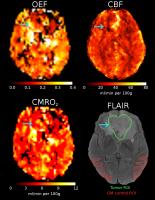 |
Mapping of brain tumor oxygen metabolism in native MRI 
Patrick Borchert1, Lasse Dührsen2, Div
S. Bolar3, Nils-Ole Schmidt2, Jan-Hendrik
Buhk1, Jens Fiehler1, and Jan Sedlacik1
1Neuroradiology, UKE, Hamburg, Germany, 2Neurosurgery,
UKE, Hamburg, Germany, 3Martinos
Center, MGH, Boston, MA, United States
The QUIXOTIC method was tested in conjunction with ASL to
map tumor oxygen metabolism in glioma patients. A higher
oxygen extraction fraction was found for low grade gliomas,
whereas lower cerebral blood flow was found for high grade
gliomas. Both parameters were stable in healthy gray matter.
These findings suggest, that the QUIXOTIC method is able to
map tumor oxygen metabolism in conjunction with ASL.
Furthermore, these findings may suggest, that low grade
gliomas may maintain a more aerobic metabolism than high
grade gliomas and that the uncontrolled tumor angiogenesis
of high grade gliomas may cause hindered tumor perfusion.
|
|
1356.
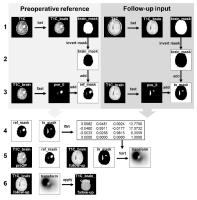 |
Validation of a semi-automatic coregistration of MRI scans in
brain tumor patients during treatment follow-up 
Jiun-Lin Yan1,2,3, Anouk van der Hoorn4,5,
Timothy J Larkin6, Natalie R Boonzaier6,
Tomasz Matys5, and Stephen J Price6
1Clinical Neuroscience, University of Cambridge,
Cambridge, United Kingdom, 2Neurosurgery,
Chang Gung Memorial Hospital, Keelung, Taiwan, 3Department
of neurosurgery, Chang Gung University College of Medicine,
Taoyuan, Taiwan, 4Department
of radiology (EB44), University Medical Centre Groningen,
Groningen, Netherlands, 5Department
of radiology, University of Cambridge, Cambridge, United
Kingdom, 6Brain
tumour imaging laboratory, University of Cambridge,
Cambridge, United Kingdom
Coregistration of lesional brain MRI between different time
points is challenging. We aimed to propose a two staged
semi-automatic coregistration methods to overcome the
difficulty. Firstly, we calculated the transformation
between presurgical tumor and postsurgical resection cavity
by using the linear FLIRT co-registration. This creates a
transformation matrix used for the progression and
pseudoprogression area with optimal correction of variable
brain shift. Then we applied this transformation matrix to a
non-linear FNIRT transformation to coregister the brain.
Validation by using registration target error showed smaller
deviation can be achieved by using this method compared to
direct non-linear registration.
|
|
1357.
 |
Contrast-Enhanced Synthetic MRI for the Detection of Brain
Metastases: Comparison Between Synthetic T1-weighted
Inversion-recovery Image, Synthetic T1-weighted Image, and
Conventional T1-weighted Inversion-recovery Fast Spin-Echo
Image. 
Misaki Nakazawa1,2, Akifumi Hagiwara2,3,
Masaaki Hori2, Christina Andica2, Koji
Kamagata2, Hideo Kawasaki2, Nao Takano2,
Shuji Sato2, Nozomi Hamasaki2, Kouhei
Tsuruta1,2, Sho Murata1,2, Ryo Ueda1,2,
Shigeki Aoki2, and Atsushi Senoo1
1Graduate School of Human Health Sciences, Tokyo
Metropolitan University, Tokyo, Japan, 2Department
of Radiology, Juntendo University School of Medicine, Tokyo,
Japan, 3Graduate
School of Medicine, The University of Tokyo, Tokyo, Japan
The purpose of this study was to assess whether
contrast-enhanced synthetic MRI is suitable for detecting
brain metastases by comparing the lesion-to-white matter
contrast, contrast-to-noise ratio, and number of brain
metastases detected in synthetic and conventional magnetic
resonance images. Synthetic T1IR images had better contrast
compared with synthetic T1W or conventional T1IR images.
Synthetic T1IR images enabled detection of more metastases
than did synthetic T1W and conventional T1IR images even
though statistical significance was not detected.
Contrast-enhanced synthetic T1IR is useful for detecting
brain metastases. Further optimization of contrast weighting
is needed to maximize the ability to detect brain
metastases. The purpose of this study was to assess whether
contrast-enhanced synthetic MRI is suitable for detecting
brain metastases by comparing the lesion-to-white matter
contrast, contrast-to-noise ratio, and number of brain
metastases detected in synthetic and conventional magnetic
resonance images. Synthetic T1IR images had better contrast
compared with synthetic T1W or conventional T1IR images.
Synthetic T1IR images enabled detection of more metastases
than did synthetic T1W and conventional T1IR images even
though statistical significance was not detected.
Contrast-enhanced synthetic T1IR is useful for detecting
brain metastases. Further optimization of contrast weighting
is needed to maximize the ability to detect brain
metastases.
|
|
1358.
 |
Bayesian Estimation of Microstructural Parameters in Glioma
Patients and Comparison with Genetic Analysis
Elias Kellner1, Marco Reisert1, Ori
Staszewski2, Bibek Dhital1, Valerij G
Kiselev1, Karl Egger3, Horst Urbach3,
and Irina Mader3
1Department of Radiology, Medical Physics,
University Medical Center Freiburg, Freiburg, Germany, 2Freiburg,
Germany, 3Department
of Neuroradiology, University Medical Center Freiburg,
Freiburg, Germany
In a recent study, we proposed a method for fast and direct
estimation of mictrostructural tissue parameters such as
intra/extraaxonal volume fraction and diffusivities based on
multishell DWI. In this study, we report the first method
application to human gliomas and demonstrate connections of
microstructural parameters with genetic markers IDH and
1p19q in a group of 32 patients.
|
|
1359.
 |
In Vivo Detection of 2-Hydroxyglutarate in Low-Grade Glioma
Patients 
Elizabeth D Phillips1, Llewellyn E Jalbert1,
Yan Li1, Marisa M Lafontaine1, and
Sarah J Nelson1
1Radiology and Biomedical Imaging, University of
California, San Francisco, San Francisco, CA, United States
While the feasibility of utilizing 2HG as a magnetic
resonance biomarker has been established ex
vivo, several different approaches to obtaining in vivo
data have been presented. This project aims to assess the
concordance of 2HG detection using asymmetric echo PRESS
MRSI with IDH1R132H mutation
as identified via antibody staining in patients with LGG,
and to investigate the relationship of other metabolites
detected with this sequence to IDH status.
Further research is required before routine clinical
implementation of these methods is recommended.
|
|
1360.
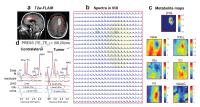 |
1H Echo Planar Spectroscopic Imaging of
2-hydroxyglutarate in Gliomas at 7T in
vivo
Zhongxu An1, Sandeep Ganji1, Vivek
Tiwari1, Marco C. Pinho1,2, Edward Pan3,4,5,
Bruce E. Mickey3,5,6, Elizabeth A. Maher3,4,6,7,
and Changho Choi1,2,3
1Advanced Imaging Research Center, University of
Texas Southwestern Medical Center, Dallas, TX, United
States, 2Department
of Radiology, University of Texas Southwestern Medical
Center, Dallas, TX, United States,3Harold C.
Simmons Cancer Center, University of Texas Southwestern
Medical Center, Dallas, TX, United States, 4Department
of Neurology and Neurotherapeutics, University of Texas
Southwestern Medical Center, Dallas, TX, United States, 5Department
of Neurological Surgery, University of Texas Southwestern
Medical Center, Dallas, TX, United States, 6Annette
Strauss Center for Neuro-Oncology, University of Texas
Southwestern Medical Center, Dallas, TX, United States, 7Department
of Internal Medicine, University of Texas Southwestern
Medical Center, Dallas, TX, United States
2-hydroxyglutarate (2HG) is the first imaging biomarker for
IDH-mutated gliomas. High-spatial resolution spectroscopic
imaging of 2HG is clinically important. We propose a new
EPSI read-out scheme to overcome the conventional limitation
of EPSI spectral bandwidth at high field. With SNR and
linewidth benefit at 7T, we demonstrated the in
vivo feasibility
of this new EPSI method in mapping of 2HG and other
important brain metabolites in normal subject and glioma
patients at 7T.
|
|
1361.
 |
Hybrid PET MRI of brain tumours: spatial relationship of tumour
volume in FET PET and 3D MRSI
Jörg Mauler1, Karl-Josef Langen1,2,
Andrew A. Maudsley3, Omid Nikoubashman4,
Christian Filss1, Gabriele Stoffels1,
and N. Jon Shah1,5
1Forschungszentrum Jülich, Jülich, Germany, 2Department
of Nuclear Medicine, Faculty of Medicine, RWTH Aachen
University, Aachen, Germany, 3Miller
School of Medicine, University of Miami, Miami, FL, United
States, 4Department
of Neuroradiology, RWTH Aachen University, Aachen, Germany, 5Department
of Neurology, Faculty of Medicine, JARA, RWTH Aachen
University, Aachen, Germany
Gliomas are characterised by an elevated expression of amino
acid transporters and cell turnover. The spatial overlap of
the corresponding volumes was analysed in 46 subjects, based
on O-(2-[18F]fluoroethyl)-L-tyrosine (FET) uptake, measured
with PET and by means of the choline to N-acetyl-aspartate
(Cho/NAA) ratio, determined by simultaneously acquired, 3D
spatially resolved MR spectroscopic imaging data. The
overlap between the respective volumes averaged out to
(30±23) % with tumour volumes of (14±15) cm3 and
(39±28) cm3 in
case of FET uptake and increased Cho/NAA-ratio,
respectively. Thus the imaging modalities may represent
different metabolic properties of gliomas.
|
|
1362.
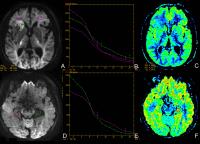 |
Apparent diffusion coefficient in preoperative grading of
gliomas: a comparison between ultra-high and conventional mono-b
value diffusion-weighted MR imaging 
YuChuan Hu1, LinFeng Yan1, ZhiCheng
Liu1, YingZhi Sun1, DanDan Zheng2,
TianYong Xu2, Wen Wang1, and GuangBin
Cui1
1Department of Radiology, Tangdu Hospital, Fourth
Military Medical University, Xi’an, China, People's Republic
of, 2MR
Research China, GE Healthcare China, Beijing, China,
People's Republic of
The preoperative grading of gliomas, which is critical for
determination of the most appropriate treatment, remains
unsatisfactory. As an improved MRI technique,
diffusion-weighted imaging (DWI) is considered the most
sensitive for early pathological changes and therefore can
potentially be useful in evaluating the glioma grades.
Recently, apparent diffusion coefficient (ADC) values
derived from the high (3000 sec/mm2) b values DWI were
reported to improve the diagnostic performance of DWI in
differentiating high- from low-grade gliomas5. But a
mono-exponential model and relatively lower high-b values
were used in this study.We used a tri-component model to
calculate ultra-high ADC (ADCuh) in our research, aiming to
retrospectively compare the efficacy of ultra-high and
conventional mono-b value DWI in the glioma grading.
|
|
1363.
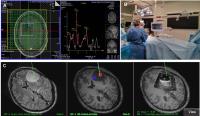 |
18F-methylcholine PET/CT and magnetic resonance spectroscopy
imaging and tissue biomarkers of cell membrane turnover in
primary brain gliomas – a pilot study 
Matthew Grech-Sollars1,2, Katherine Ordidge1,2,
Babar Vaqas3, Lesley Honeyfield2,
Sameer Khan2, Sophie Camp3, David
Towey2, David Peterson3, Federico
Roncaroli4, Kevin S O'Neill3, Tara
Barwick2,5, and Adam D Waldman1,2
1Division of Brain Sciences, Imperial College
London, London, United Kingdom, 2Department
of Imaging, Imperial College NHS Healthcare Trust, London,
United Kingdom, 3Department
of Neurosurgery, Imperial College NHS Healthcare Trust,
London, United Kingdom, 4Department
of Neuropathology, Imperial College NHS Healthcare Trust,
London, United Kingdom, 5Department
of Surgery and Cancer, Imperial College London, London,
United Kingdom
Choline elevation has been reported as a marker of
aggressive glioma phenotype in numerous in vivo MRS studies,
and more recently 18F-methylcholine-PET has been applied to
glioma characterisation. This study examines the
relationship between MRS and PET choline measures in defined
tumour regions, in order to validate these against tissue
biomarkers of choline metabolism and proliferation. Our
initial results raise the possibility that imaging markers
of choline metabolism are influenced by inflammatory and
reactive processes for low grade tumours.
|
|
1364.
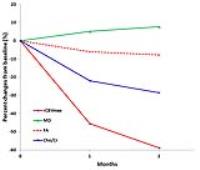 |
Assessment of Anti-EGFRvIII Chimeric Antigen Receptor (CAR) T
cell Therapy for Patients with Glioblastomas using Diffusion,
Perfusion and MR Spectroscopy
Sumei Wang1, Donald M O’Rourke2,
Sanjeev Chawla1, Gaurav Verma1,
Gabriela Plesa3, Carl H June3, Marcela
V Maus4, Steven Brem2, Eileen Maloney2,
Jennifer JD Morrissette5, Maria Martinez-Lage5,
Arati Desai6, Ronald L Wolf1, Harish
Poptani1,7, and Suyash Mohan1
1Radiology, University of Pennsylvania,
Philadelphia, PA, United States, 2Neurosurgery,
University of Pennsylvania, Philadelphia, PA, United States, 3Pathology
and Laboratory Medicine, Center for Cellular
Immunotherapies, University of Pennsylvania, Philadelphia,
PA, United States, 4Center
for Cancer Immunology, Massachusetts General Hospital Cancer
Center, Charlestown, MA, United States, 5Pathology
and Laboratory Medicine, University of Pennsylvania,
Philadelphia, PA, United States, 6Hematology-Oncology,
University of Pennsylvania, Philadelphia, PA, United States, 7Cellular
and Molecular Physiology, University of Liverpool,
Liverpool, United Kingdom
Chimeric Antigen Receptor (CAR) T cell therapy is a novel
method of treating tumors. Since EGFRvIII is expressed in
some glioblastomas, we evaluated the efficacy of
anti-EGFRvIII CART for treating these tumors. Treatment
response was assessed via serial MRI scans at 1 and 2 months
after CAR-T cell therapy. The rCBVmax and Cho/Cr ratio
decreased whereas MD and FA stayed relatively stable for
most patients, indicating a positive response that can be
assessed by these methods.
|
|
1365.
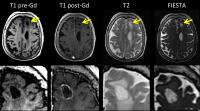 |
Fast Imaging Employing Steady-State Acquisition of Brain
Metastasis: from mouse to woman
Donna H Murrell1,2, Keng Yeow Tay3,
Eugene Wong2,3, Ann F Chambers2,3,
Francisco Perera3, and Paula J Foster1,2
1Imaging Research Laboratories, Robarts Research
Institute, London, ON, Canada, 2Department
of Medical Biophysics, Western University, London, ON,
Canada, 3London
Health Sciences Centre, London, ON, Canada
Brain metastatic burden may be underestimated in the clinic
because some tumors are impermeable to Gadolinium (Gd).
Preclinical studies by our group demonstrated that fast
imaging employing steady-state acquisition (FIESTA) was
advantageous for detecting small Gd-impermeable tumors.
Here, we show clinical translation of this imaging strategy.
We present FIESTA images of human brain metastasis alongside
standard clinical MRI and illustrate potential clinical
utility of this sequence. Initial data suggests FIESTA can
visualize intra-tumor heterogeneity where standard clinical
MRI could not. Additional lesions were observed in FIESTA;
we hypothesize some may be arachnoid cysts, though
metastasis cannot be ruled out.
|
|
1366.
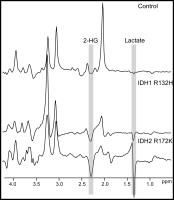 |
Distinguishing the Chemical Signature of Different IDH Mutations
in Brain Tumor Patients at 7 Tesla 
Uzay E Emir1, Sarah Larkin2, Nick de
Pennington2, Puneet Plaha3, Natalie
Voets1, James Mccullagh4, Richard
Stacey3, Peter Jezzard1, Stuart Clare1,
Christopher Schofield4, Tom Cadoux-Hudson3,
and Olaf Ansorge2
1FMRIB Centre, University of Oxford, Oxford,
United Kingdom, 2Nuffield
Department of Clinical Neurosciences, University of Oxford,
Oxford, United Kingdom, 3Department
of Neurosurgery, John Radcliffe Hospital, Oxford University
Hospitals NHS Trust, Oxford, United Kingdom, 4Department
of Chemistry, University of Oxford, Oxford, United Kingdom
In this study, we show a proton magnetic resonance
spectroscopy (1H-MRS) acquisition scheme at 7T,
enabling discernible 2-HG in the spectra of IDH-mutant
patients acquired within 20s and quantify metabolic changes
associated with the IDH mutation. Due to the increased
sensitivity and specificity of this scheme at 7T, we
demonstrate elevated 2-HG and Lactate accumulation in IDH2
R172K (mitochondrial) compared to the IDH1 R132H (cytosolic)
mutant tumors in human brains noninvasively.
|
|
1367.
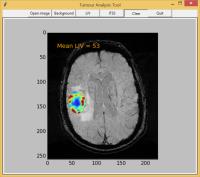 |
Developing a Semi-Automatised Tool for Grading Brain Tumours
with Susceptibility-Weighted MRI
Maria Duvaldt1 and
Tomas Jonsson1
1Dept. of Medical Physics, Karolinska University
Hospital, Stockholm, Sweden
In order to make an adequate decision on the further
treatment of a glioma cancer patient a tissue sample from
the tumour is microscopically analysed and classified on a
malignancy scale set by the WHO. In this project a software
program with a graphical user interface is developed, where
the malignancy grade of a tumour could be found by image
analysis of susceptibility-weighted MR images. The
parameters examined are the local image variance and
intratumoural susceptibility signal and the results show the
possibility of distinguishing high grade from low grade
astrocytoma by image analysis only.
|
|
1368.
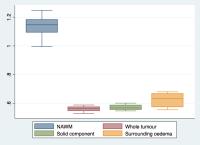 |
Non-Gaussian measurements of water diffusion in glioma as a tool
for probing tumor heterogeneity and grade. 
Fulvio Zaccagna1, Frank Riemer1, Mary
McLean2, Andrew N. Priest3, James T.
Grist1, Joshua Kaggie1, Sarah Hilborne1,
Tomasz Matys1, Martin J. Graves1,
Jonathan H. Gillard1, Stephen J. Price4,
and Ferdia A. Gallagher1
1Department of Radiology, University of
Cambridge, Cambridge, United Kingdom, 2Cancer
Research UK Cambridge Institute, University of Cambridge,
Cambridge, United Kingdom, 3Radiology,
Cambridge University Hospitals NHS Foundation Trust,
Cambridge, United Kingdom, 4Neurosurgery
Unit, Department of Clinical Neurosciences, University of
Cambridge, Cambridge, United Kingdom
Glioma grade and extent of local infiltration are used to
guide surgical tumor management. Heterogeneity imaging is a
way of assessing the tumor microenvironment, which may
improve diagnosis and therapy planning. Diffusion Kurtosis
Imaging (DKI) is a novel promising technique that estimates
non-Gaussian water diffusion as a measure of heterogeneity.
We investigate the use of DKI in glioma as a tool to improve
tumor grading and to estimate infiltration. Our preliminary
results show a mean kurtosis of 0.56±0.02 in glioblastoma
and 1.14±0.07 in normal-appearing white matter. DKI may thus
represent a useful tool for estimation of tumor
heterogeneity in glioma.
|
|
1369.
 |
Impact of semi-automatic delineation of hotspots of contrast
enhancing region in predicting the outcome of GBM patients after
brain surgery 
Adrian Ion-Margineanu1,2, Sofie Van Cauter3,4,
Diana M Sima1,2, Frederik Maes2,5,
Stefan Sunaert3, Stefaan Van Gool6,
Uwe Himmelreich7, and Sabine Van Huffel1,2
1ESAT - STADIUS, KU Leuven, Leuven, Belgium, 2Medical
IT, iMinds, Leuven, Belgium, 3Department
of Radiology, University Hospitals of Leuven, Leuven,
Belgium, 4ZOL
- Ziekenhuis Oost-Limburg, Genk, Belgium, 5ESAT
- PSI, KU Leuven, Leuven, Belgium, 6Department
of Pedriatic Neuro-Oncology, University Hospitals of Leuven,
Leuven, Belgium, 7Department
of Imaging and Pathology, Biomedical MRI / MoSAIC, Leuven,
Belgium
Delineating contrast enhancing (CE) tissue is an integral
part of the RANO criteria for therapy response assessment in
high-grade gliomas. We propose a semi-automatic delineation
of hotspots of CE (HCE) in brain tumour follow-up of 29
glioblastoma multiforme patients after surgery. Based on
multi-parametric magnetic resonance data we predict the
post-operative evolution of the brain tumour by labelling
each patient at each time point as responsive or
progressive. The results obtained with our semi-automatic
method are better in most of the cases than the results
obtained with the original manual delineations. Moreover,
our method can efficiently impute missing data.
|
|
1370.
 |
Automatic normalization of DCE-MRI derived cerebral blood volume
(CBV) may improve glioma grading
Prativa Sahoo1, Indrajit Saha2, and
Rakesh Kumar Gupta3
1Healthcare, Philips India ltd, Bangalore, India, 2Philips
Healthcare, Philips India ltd, Gurgaon, India, 3Radiology
and Imaging, Fortis Memorial Research Institute, Gurgaon,
India
DCE-MRI derived relative blood volume (rCBV) correlates
excellently with grade of glioma. Traditionally rCBV is
calculated by dividing CBV value of tumor region with the
CBV value from the corresponding contra-lateral region by
identifying and placing region of interest (ROI). This
technique is tedious needs user expertise. The main aim of
this study was to develop an automatic method to normalize
CBV so that the user-induced biasness in glioma grading due
to ROI placement can be reduced. Normalized CBV provides a
better contrast between tumor and normal region
|
|
1371.
 |
The Value of CBF Combined With Temporal Information in Grading
High-Grade Astrocytomas: A Multi-Inversion-Time
Arterial-Spin-Labeling Magnetic Resonance Study 
Shuang Yang1, Tianyi Qian2, Jianwei
Xiang1, Yingchao Liu3, Fei Gao1,
Peng Zhao3, Josef Pfeuffer4, Guangbin
Wang1, and Bin Zhao1
1Shandong Medical Imaging Research Institute,
Shandong University, Jinan, China, People's Republic of, 2MR
Collaborations NE Asia, Siemens Healthcare, Beijing, China,
People's Republic of, 3Shandong
provincial Hospital, Shandong University, Jinan, China,
People's Republic of, 4Application
Development, Siemens Healthcare, Erlangen, Germany
This study aimed to demonstrate the feasibility of
multi-inversion-time arterial spin labeling (mTI-ASL) for
differentiating between WHO III and WHO IV grade
astrocytomas, as well as the added value of bolus arrival
time (BAT) information in evaluating tumor perfusion. In the
first part of this study, we evaluated the reproducibility
of mTI-ASL in healthy subjects, and then mTI-ASL was used to
evaluate 45 astrocytoma patients. There was no major
variation between two consecutive mTI-ASL measurements in
healthy volunteers. Furthermore, mTI-ASL provided valuable
information for the classification of astrocytomas, while
BAT added relevant information for grading by estimating the
temporal dynamics of local tumor-mass perfusion.
|
|
1372.
 |
The effect of prophylactic cranial irradiation on brain
diffusion and magnetization transfer
Mary A McLean1, Nicola L Ainsworth1,2,
Anna M Brown1, Susan V Harden2, and
John R Griffiths1
1CRUK Cambridge Institute, University of
Cambridge, Cambridge, United Kingdom, 2Oncology,
Addenbrooke's Hospital, Cambridge, United Kingdom
We investigated the effect of prophylactic cranial
irradiation (PCI: 25 Gy in 10 fractions) on brain MRI at 3T.
Six patients with small cell lung cancer were scanned at
4-month intervals: at diagnosis, following chemotherapy, and
following PCI. Paired t-tests before and after PCI in right
frontal white matter showed increased ADC and decreased FA
and MTR following treatment. However, the parameters did not
differ significantly from the scan at diagnosis, and other
brain regions showed no significant changes on
repeated-measures ANOVA. These observations are consistent
with previous reports of more marked changes following
higher-dose radiotherapy treatment.
|
|
1373.
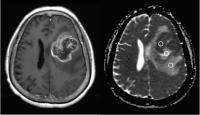 |
Differentiation of Glioblastoma Multiforme and Primary Cerebral
Lymphoma with Diffusion-Weighted MR Imaging 
Ching Chung Ko1,2, Yu Chang Lee3, Ming
Hong Tai2, Tai Yuan Chen1, Yu Ting Kuo1,
and Jeon Hor Chen3,4
1Department of Medical Imaging, Chi Mei Medical
Center, Tainan, Taiwan, 2Institute
of Biomedical Science, National Sun Yat-Sen University,
Kaohsiung, Taiwan, 3Department
of Radiology, I-Shou University and Eda Hospital, Kaohsiung,
Taiwan, 4Center
for Functional Onco-Imaging, University of California,
Irvine, CA, United States
Atypical glioblastoma multiformes (GBMs) with solid
enhancing tumor and without visible necrosis may mimic
primary cerebral lymphomas (PCLs), and atypical PCLs with
visible necrosis may mimic GBMs. This study aimed to
differentiate these two brain tumors using qualitative DWI
signals and quantitative ADC values acquired in tumoral
necrosis, the most enhanced tumor area, and the peritumoral
edema. The results showed GBMs tended to have significantly
higher ADC in the enhanced tumor area, and lower ADC in the
peritumoral edema area than PCLs.
|
|
1374.
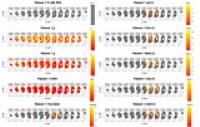 |
IDH-1 Mutation and Non-Enhancing Component of Glioblastoma
Daniel M Fountain1, Timothy J Larkin2,
Natalie R Boonzaier2, Jiun-Lin Yan2,
and Stephen J Price2
1The Brain Tumour Imaging Laboratory, Division of
Neurosurgery, University of Cambridge, Cambridge, United
Kingdom, 2Division
of Neurosurgery and Wolfson Brain Imaging Centre, The Brain
Tumour Imaging Laboratory, Cambridge, United Kingdom
IDH-1 mutated glioblastoma is associated with improved
survival, and greater sensitivity to further resection of
non-enhancing disease than IDH-1 wild-type. We used
structural, diffusion tensor, perfusion and spectroscopic
imaging data in a mixed model across the peritumoral region
in 54 patients. Applying a mixed model methodology across
three levels of data resolution, we demonstrated that IDH-1
mutated tumors demonstrated raised choline and lowered
glutamate and glutamine compared to IDH-1 wild-type. The
findings provided an AUC of 0.943 when combined with age. We
hypothesised this results in greater sensitivity to
treatment and reduced excitotoxicity, thus explaining their
relatively superior prognosis.
|
|
1375.
 |
Evaluation of 7T MRI for endoscopic surgical planning and
guidance for skull base tumors - preliminary experience
Hadrien A Dyvorne1, Thomas F Barrett2,
Bradley N Delman3, Raj K Shrivastava2,
and Priti Balchandani1
1Translational and Molecular Imaging Institute,
Icahn school of Medicine at Mount Sinai, New York, NY,
United States, 2Neurosurgery,
Icahn School of Medicine at Mount Sinai, New York, NY,
United States,3Radiology, Icahn school of
Medicine at Mount Sinai, New York, NY, United States
Skull based tumors pose some of the most complex challenges
in neurosurgery owing to their proximity to important
structures such as optic nerves and arteries. For this
reason, surgical planning heavily depends on high quality MR
images. In this study we evaluated the performance of 7T
imaging against standard scans at 3T and 1.5T for
delineating such structures. Furthermore, the
high-resolution scans were integrated in the neurosurgical
workflow in order to evaluate improvements in surgical time
and confidence of surgical decision-making.
|
|
1376.
 |
Semi-automatic segmentation of medulloblastoma using active
contour method
Ka Hei Lok1, Lin Shi2,3, Queenie Chan4,
and Defeng Wang5,6
1Department of Imaging and Intenvntional
Radiology, The Chinese University of Hong Kong, Sha Tin,
Hong Kong, 2Department
of Medicine and Therapeutics, The Chinese University of Hong
Kong, Sha Tin, Hong Kong,3Chow Yuk Ho Technology
Centre for Innovative Medicine, The Chinese University of
Hong Kong, Sha Tin, Hong Kong, 4Philips
Healthcare, Hong Kong, Hong Kong, 5Research
Center for Medical Image Computing, Department of Imaging
and Intenvntional Radiology, The Chinese University of Hong
Kong, Sha Tin, Hong Kong, 6Shenzhen
Research Institute, The Chinese University of Hong Kong,
Shenzhen, China, People's Republic of
Brain tumours are the second commonest form of childhood
malignancy while medulloblastoma is the most common brain
tumor in children. Accurate Segmentation of medulloblastoma
is necessary for maximum tumor surgical removal. We proposed
a novel method to segment medulloblastoma by modifying
signed pressure function (SPF) function in Gaussians
Filtering Regularized Level Set (SBGRLS) method.
Quantitative validation is performed in this project. The
method is proved to be clinical-oriented which is fast,
robust, accurate with minimal user interaction.
|
|
1377.
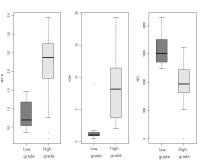 |
Withdrawn - Value of Amide Proton Transfer Imaging in
Correlation with Histopathological Grades of Adult Diffuse
Gliomas : Comparison and Incremental Value with Dynamic
Susceptibility Contrast-Enhanced MRI and Diffusion Weighted
Imaging
Seung-Koo Lee1, Yoon Seong Choi2, Sung
Soo Ahn1, Ho-Joon Lee1, and Jinna Kim1
1Seoul, Korea, Republic of, 2Radiology,
Severance Hospital, Yonsei University College of Medicine,
Seoul, Korea, Republic of
We investigated the difference in APT values according to
histopathological grades, and compared the diagnostic value
of APT with relative cerebral blood volume (rCBV) from
dynamic susceptibility contrast-enhanced (DSC) MRI and
apparent diffusion coefficient (ADC) from diffusion weighted
imaging (DWI) for histopathological grades in adult diffuse
gliomas. We optimized APT imaging protocol for clinical
setting and found that APT values were increased along with
glioma grades, and APT values has incremental values over
ADC values for glioma grading. We suggest that APT imaging
can be a useful noninvasive imaging biomarker for glioma
grading, in combination with ADC.
|
|
1378.
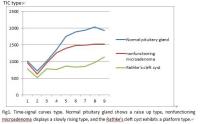 |
Time-signal curves analysis of dynamic contrast-enhanced
magnetic resonance imaging used in differential diagnosis of
pituitary lesions. 
shiyun tian1, Weiwei Wang1, and yanwei
miao1
1Radiology Department, the First Affiliated
Hospital of Dalian Medical University, Dalian, China,
People's Republic of
Pituitary microadenomas are commonly visualized as
well-defined lesions that enhance less than the normal
pituitary gland, but it is not clear about the enhancement
pattern of microadenomas. Our work is to evaluate the TIC
type and the five parameters extracted from time-signal
curves of DCE-MRI in the normal pituitary gland,
microadenoma and the Rathke’s cleft cyst.
|
|
1379.
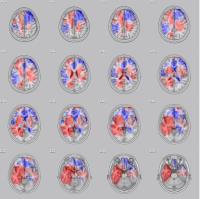 |
MR based texture and location analysis of lower grade gliomas
combined with genetic mutation information 
Manabu Kinoshita1, Hideyuki Arita2,
Mio Sakai3, Naoki Kagawa2, Yonehiro
Kanemura4, Yasunori Fujimoto2,
Katsuyuki Nakanishi3, and Toshiki Yoshimine2
1Neurosurgery, Osaka Medical Center for Cancer
and Cardiovascular Diseases, Osaka, Japan, 2Neurosurgery,
Osaka University Graduate School of Medicine, Suita, Japan, 3Radiology,
Osaka Medical Center for Cancer and Cardiovascular Diseases,
Osaka, Japan, 4National
Hospital Organization Osaka National Hospital, Osaka, Japan
Extensive genetic analysis of WHO grade 2 and 3 gliomas
(lower grade glioma) revealed that they comprise of several
disease subtypes with different genetic or molecular
backgrounds. The present investigation was conducted to
elucidate the differences revealed on MR images including
textures and locations of the tumors according to genetic
mutation status (IDH and TERT promoter mutation) of lower
grade gliomas. T2-entropy, a newly introduced image texture
metric revealed that tumor heterogeneity is different
depending on genetic status. Furthermore, classic
oligodendroglial tumors located at the mid-base frontal lobe
while astrocytic tumors occupied much lateral side of the
brain.
|
|
1380.
|
RADIOMICS of advanced multiparmetric MRI in posterior fossa
tumors is supreme to the domain wizards! A pilot study
Shanker Raja1, Sarah Farooq2, William
Plishker3, Ali Daghriri4, Sadeq Wasil
Al-Dandan5, Abdullah Ali Alrashed4,
Muhammad Usman Manzoor6, and Sharad George7
1Baylor College of Medicine, Bellaire, TX, United
States, 2King
Fahad Medical City, Riyadh, Saudi Arabia, 3IGI
Technologies, College Park, MD, United States, 4Medical
Imaging, King Fahad Medical City, Riyadh, Saudi Arabia, 5Pathology
and Laboratory Medicine, King Fahad Medical City, Riyadh,
Saudi Arabia, 6Radiology,
King Fahad Medical City, Riyadh, Saudi Arabia, 7Johns
Hopkins Aramco Healthcare, Dhahran, Saudi Arabia
We uniquely extracted textural features from multiple
sequences of advanced FMRI to preoperatively differentiate
posterior fossa tumor histology. Furthermore, as opposed to
recently published work (1,3,4) we found that in our
series, textural feature subset derived from perfusion
images is slightly superior to those of ADC maps. In
addition, as expected, the observations from this work
concurs that RADIOMICS is definitely on par and probably
surpasses domain experts in this endevour.
|
|
1381.
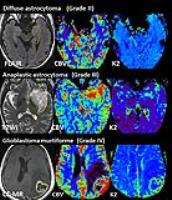 |
Evaluation of vascular permeability in gliomas by using
parameter K2 from dynamic susceptibility contrast data-sets and
histogram analysis. 
Toshiaki Taoka1, Hisashi Kawai1,
Toshiki Nakane1, Toshiteru Miyasaka2,
and Shinji Naganawa1
1Radiology, Nagoya University, Nagoya, Japan, 2Radiology,
Nara Medical University, Kashihara, Japan
Permeability images can provide additional information to
perfusion images in the clinical practice of brain tumors.
However, permeability imaging by dynamic contrast
enhancement methods requires a long acquisition time. K2 is
an index that represents permeability and can be calculated
from the dataset of perfusion images with the dynamic
susceptibility contrast method, which requires a short
acquisition time. In the current study, we calculated K2 for
various grades of gliomas and found that K2 showed a
significantly higher 20th percentile value in Grade IV
compared to Grade III gliomas, providing useful information
for grading of gliomas.
|
|
1382.
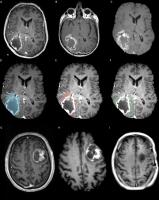 |
Characterising tumour progression and pseudoprogression on
preoperative multimodal MRI imaging 
Jiun-Lin Yan1,2,3, Anouk van der Hoorn4,
Timothy J Larkin5, Natalie Rosella Boonzaier5,
Tomasz Matys6, and Stephen J Price5
1Clinical Neuroscience, University of Cambridge,
Cambridge, United Kingdom, 2Department
of neurosurgery, Chang Gung Memorial Hospital, Keelung,
Taiwan, 3Department
of neurosurgery, Chang Gung University College of Medicine,
Taoyuan, Taiwan, 4Department
of radiology (EB44), University of Groningen, Groningen,
Netherlands, 5Brain
tumour imaging laboratory, University of Cambridge,
Cambridge, United Kingdom,6Department of
radiology, University of Cambridge, Cambridge, United
Kingdom
Glioblastoma is a highly malignant tumor which recur mostly
within 2 cm around the resected contrast enhancement.
However, it is difficult to identify tumor invasiveness
pre-surgically especially in non-enhanced area. Thus, we
aimed to identify possible imaging characteristics
preoperatively using multimodal MR techniques in the
peritumoral regions that eventually leads to tumor
recurrence or progression. Our study showed lower isotorpic
p, anisotopic q and ADC for progression compared to
non-progression regions. In addition, MRS showed a not
statistically significant trend of higher choline/NAA,
higher choline and lower NAA in these progression area.
|
|
1383.
|
Radiogenomic Mapping of Dysregulated Angiogenesis in
Glioblastoma.
Kevin, Li-Chun Hsieh1, Fei-Ting Hsu1,
Chia-Feng Lu1, and Cheng-Yu Chen1
1Translational Imaging Research Center, Taipei
Medical University, Taipei, Taiwan
In this TCGA study, we identified several qualitative and
quantitative radiomics imaging surrogates in glioblastoma,
which can be used to differentiate whether this tumor have
dysregulated angiogenesis at the molecular level. These
features can also be used to predict disease survival.
|
|
1384.
 |
Differentiation of glioblastoma multiforme and single brain
metastasis by the distribution pattern of intratumoral
susceptibility sign derived from susceptibility-weighted imaging
Hyunkoo Kang1 and
Keuntak Roh1
1Department of Radiology, Seoul Veterans
Hospital, Seoul, Korea, Republic of
Susceptibility-weighted imaging (SWI) is an emerging
magnetic resonance imaging (MRI) technique that exploits the
susceptibility differences between the tissues. SWI provides
the enhancement of small vessels and microhemorrhages and
detection of iron in the brain. These characteristics permit
SWI to show anatomical and functional heterogeneity of brain
tumors by exquisite sensitivity to the blood products and
venous vasculature. The aim of this study is to determine
whether the distribution pattern of intratumoral
susceptibility sign (ITSS) derived from SWI could
differentiate glioblastoma multiforme (GBM) and single brain
metastasis. We investigated the distribution patterns of
ITSS of the tumors and applied an ITSS grading system based
on the degree of the ITSS. Then, we compared the grade of
the visibility of ITSS in the central portion of tumors
(CITSS) and in the tumor capsular area (PITSS) on SWI in
consensus. In clinical use, SWI is also useful for
differentiating GBMs from metastases.
|
|
1385.
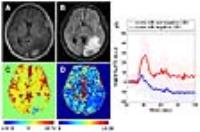 |
Differentiating contrast-enhanced glioma from peritumoral edema
using the intravascular fraction derived from IVIM MRI - a
comparative study with DSC MRI
Yen-Shu Kuo1,2, Han-Min Tseng3, and
Wen-Chau Wu4
1Graduate Institute of Biomedical Electronics and
Bioinformatics, National Taiwan University, Taipei, Taiwan, 2Radiology,
Cathay General Hospital, Taipei, Taiwan, 3Neurology,
National Taiwan University Hospital, Taipei, Taiwan, 4Graduate
Institute of Oncology, National Taiwan University, Taipei,
Taiwan
In this study, we performed intravoxel incoherent motion (IVIM)
MRI in 25 patients with histologically proven gliomas, and
compared the intravascular fraction f with
the cerebral blood volume derived from dynamic
susceptibility-contrast (DSC) MRI (CBVDSC).
Results showed that f was able to differentiate
contrast-enhanced glioma from peritumoral edema by detecting
elevated vascularity. Cross-modal comparison indicated that f correlated
better with contrast-leakage-corrected CBVDSC than
uncorrected value.
|
|
1386.
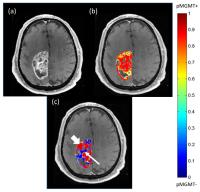 |
Normalization of Multi-contrast MRI and Prediction of Tumor
Phenotypes
Yong Ik Jeong1, Charles Cantrell1,
David Manglano1, Thomas Gallagher1,
Jeffery Raizer1, Craig Horbinski1, and
Timothy J Carroll1
1Northwestern University, Chicago, IL, United
States
Genetic profiling of cancers has the potential to identify
epigenetic changes that predict response to treatments. In
this study, we try to overcome the limitations posed by
heterogeneity of tumor phenotypes by using normalized
quantitative MRI to predict local gene expression. We report
the findings of retrospectively comparing T1, T1 post Gd, T2
and ADC to Verhaak subtypes and pMGMT methylation status in
histologically confirmed GBM patients.
|
|
1387.
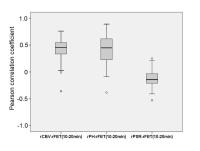 |
Intra- and inter-individual association of FET-PET- and
MR-Perfusion-parameters in untreated glioma
Jens Goettler1, Anne Kluge1, Mathias
Lukas2, Stephan Kaczmarz1, Jens Gempt3,
Florian Ringel3, Mona Mustafa2, Markus
Schwaiger2, Claus Zimmer1, Stefan
Foerster2, Christine Preibisch1,4, and
Thomas Pyka2
1Department of Neuroradiology, Technische
Universität München, Munich, Germany, 2Clinic
for Nuclear Medicine, Technische Universität München,
Munich, Germany, 3Clinic
for Neurosurgery, Technische Universität München, Munich,
Germany, 4Clinic
for Neurology, Technische Universität München, Munich,
Germany
18F-fluoroethyltyrosine (FET) PET and dynamic
susceptibility contrast (DSC) perfusion weighted imaging are
useful imaging techniques to diagnose glioma and to
delineate tumor extension. However it is still unclear
whether static and dynamic parameters of FET-PET and DSC are
associated with each other. In this study we examined 45
patients with glioma in a hybrid PET-MR 3T scanner
assessing FET time-activity-curves and DSC-parameters
simultaneously. Static as well as dynamic PET-measures
highly correlated with DSC-parameters such as relative
cerebral blood volume (rCBV) and relative peak height (rPH).
Results point to a complementary
role of both modalities pre-therapeutically.
|
|
1388.
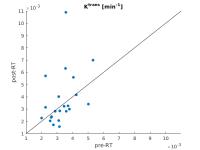 |
Estimating damage to the blood-brain barrier from radiotherapy
treatment
Magne Kleppestø1, Christopher Larsson1,
and Atle Bjornerud1,2
1The Intervention Centre, Oslo University
Hospital, Oslo, Norway, 2Department
of Physics, University of Oslo, Oslo, Norway
Brain tumors are usually subjected to radiation therapy upon
diagnosis. In this work, it is made an attempt at
investigating if this therapy might cause injury to the
non-cancerous parts of the brain. To this end dynamic
contrast-enhanced MRI was used to estimate leakage across
the blood-brain barrier.22 patients were imaged before and
after undergoing a treatment schedule, and findings from the
two examinations were compared to uncover any change. The
data shows no significant variation in either permeability
or blood plasma volume.
|
|
1389.
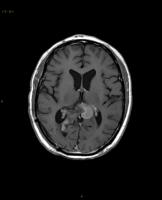 |
MR appearance of Primary central nervous system lymphoma: as
prognostic factors influencing the response to clinical
treatment
jing Liu1 and
shuixing Zhang1
1Radiology, Department of Radiology, Guangdong
Academy of Medical Sciences/Guangdong General Hospital,
Guangzhou, Guangzhou, China, People's Republic of
Currently, the treatment response in primary central nervous
system lymphoma (PCNSL) is monitored by serial
contrast-enhanced anatomic MR imaging, which often showing
characteristic radio-morphological features such as lesion
location, strong and homogenous contrast-enhancement,
moderate edema and absence of necrosis. The purpose of our
study was to investigate the objective response rate (ORR)
and identify MR findings as predictors to evaluate the
therapeutic response in PCNSL. Our result shows that tumor
size, number, location, homogenous enhancement and the
planned therapeutic strategy were independent factors
correlated with treatment response in patients of PCNSL.
|
|